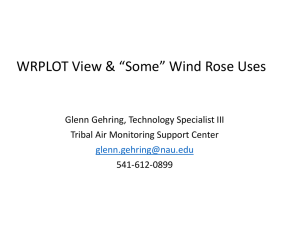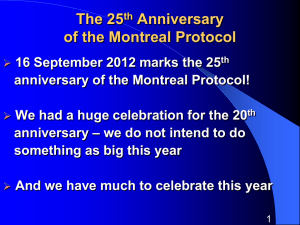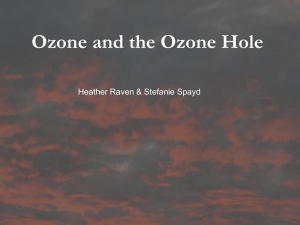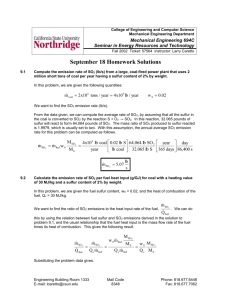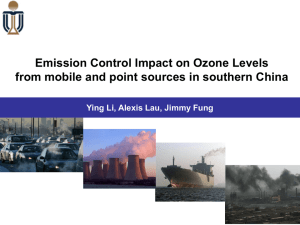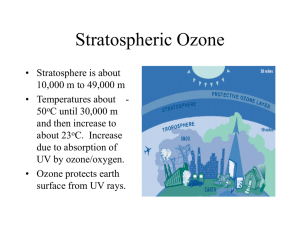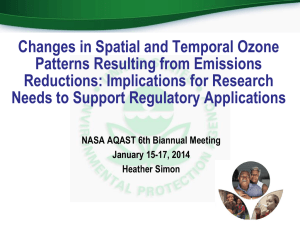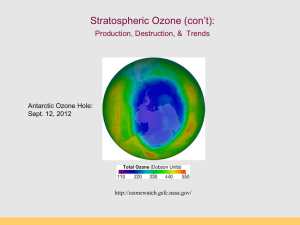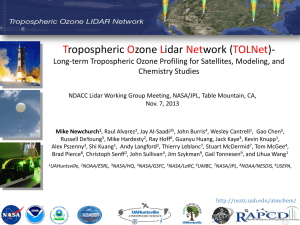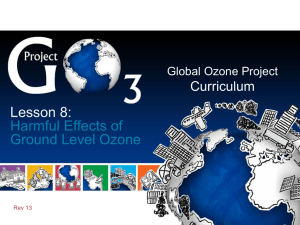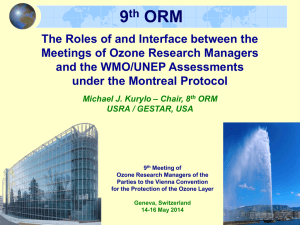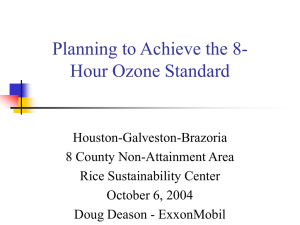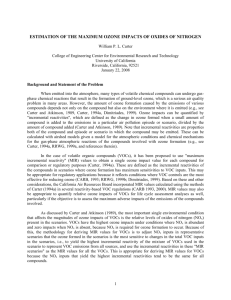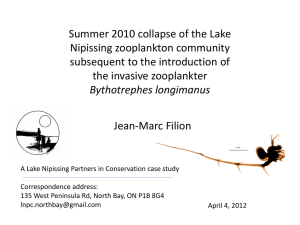Presentation_Novus_craz_May 3
advertisement
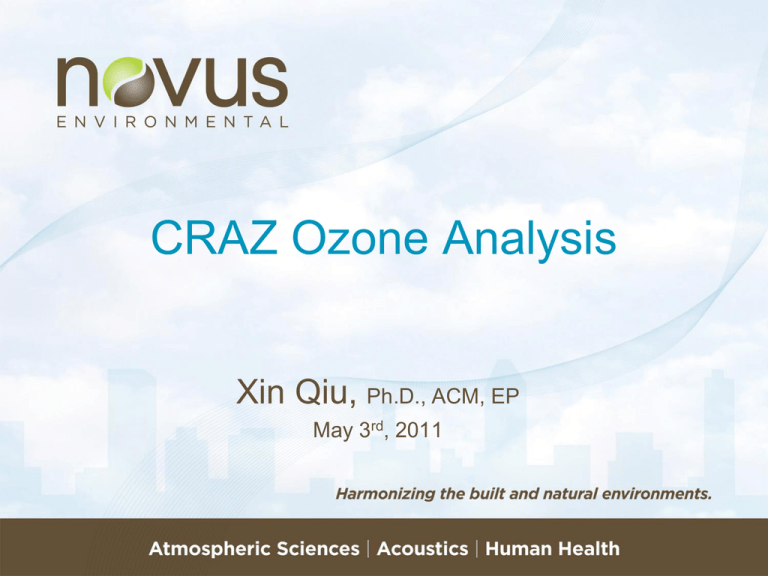
CRAZ Ozone Analysis Xin Qiu, Ph.D., ACM, EP May 3rd, 2011 Objectives • Perform an analysis of the factors contributing to high ozone days in CRAZ • Identify and assess the drivers for local and regional ozone formation • Understand ozone formation mechanism as NOx-Limited vs VOC-Limited • Provide additional support to identify “back-out” situations AQ Issues NOx O3 Primary Emissions VOCs NOX SO2 NH3 Secondary Pollutants PM2.5 CASA Action Levels Source: Alberta Environment, Particulate Matter and Ozone Assessment for Alberta 2001- 2007 Data and Models Nine Years of data (2001 -2009) • Meteorological Data – The National Climatic Data Center archives of surface and upper air data in North America • Air Quality Data – CASA measurements of ambient concentrations of ozone in/out of CRAZ Tools • HYSPLIT Back Trajectory Model • Synoptic Classification • Statistical Analysis CRAZ Area & Its Monitoring Stations CRAZ High Ozone Days 2001 – 2009 2009 12-Apr-09 2008 2007 12-May-07 2006 12-May-06 18-Apr-09 02-Jun-07 01-May-09 2005 2004 17-May-04 2003 09-Apr-03 2002 14-Apr-02 2001 13-May-01 23-Jul-06 03-Jun-04 25-May-03 13-Jun-02 26-May-01 04-Jun-07 08-Aug-06 04-Jun-04 29-May-03 21-Jun-02 29-May-01 23-May-09 15-Jul-07 06-Sep-06 30-Jun-03 22-Jun-02 12-Aug-01 24-May-09 03-Aug-07 22-Jul-03 13-Jul-02 25-May-09 23-Jul-03 16-Jul-02 03-Jun-09 24-Jul-03 17-Jul-02 25-Jul-09 08-Aug-03 18-Jul-02 27-Aug-09 09-Aug-03 01-Sep-09 13-Aug-03 14-Aug-03 15-Aug-03 Threshold: O3 8-hr mean > 58 ppb Back Trajectory Model • The Hybrid Single Particle Lagrangian Integrated Trajectory (HYSPLIT) model developed by the National Oceanic and Atmospheric Administration (NOAA) • By incorporating receptor location coordinates, altitudes, run time, and meteorological data, the model provides back trajectory history from the receptor to the source over a given period of time. Definitions • Long-range: Clear stretch of trajectories from one direction; high ozone due to long-range transport from emission sources outside of Alberta. This is the case can be “backed out”. • Local: trajectories are mostly localized, particularly at low and middle altitude. High ozone mainly due to local emissions and the Management Plan should be in place. • Mixed-Range: trajectories are slightly beyond local (CRAZ) area, or the transport within province (e.g., transport from Edmonton). This is usually a complicated situation and we further look into case by case. • Dominated Wind Direction: defined as the direction where air mass moves from according to the majority of backtrajectories. • Long-range • Local - 1 • Local - 2 • Mixed range Summary Table Weather Pattern Long Range (25/48) DM-P (2 1/48) Apr 18, 2009 May 27, 2009 Local Transport (14/48) Mixed Range (10/48) Pressure System Type Medium High W W ALL ALL SW SE W SW W ALL ALL W W N,NW SW SW S SW SW S SW SW 13.8 20.2 22.2 28.8 24.7 27.6 21.7 26.5 24.1 31.1 26.9 5.4 5.4 2.7 2.4 2.3 2.9 2.6 2.9 5.1 3.3 2.9 High High High High High High High High High High High NNW N N 18.2 2.7 High W W,SW SW SW N ALL W NE N,NW W SW SW SE N S SW E NW W SW SW NE NW SW S,SW W W 21.0 24.3 29.8 25.4 23.7 26.1 28.8 21.6 30.4 2.8 3.3 3.6 3.8 1.9 4.1 3.3 3.8 2.5 High High High High High High High High High Jul, 13, 2002 Jul, 17, 2002 Jul, 15, 2007 W S ALL W W SW S,SW SW SW W W N,NW NW S ALL W SW SW SW ALL SW SW S W W W W W SW SW SW SW SW SW N,NW SW SW ALL W SS SW SW SW SW SW S W W W SW W SW SW SW SW SW SW NW W SW SW W SW NW SW S S SW SW 14.2 21.6 19.3 23.1 27.0 16.3 22.4 31.0 29.9 22.7 22.8 13.2 20.4 26.1 23.4 24.4 31.8 28.4 29.1 32.4 34.0 32.8 28.7 3.9 2.7 4.5 4.2 4.8 6.8 5.7 2.9 4.1 4.8 6.3 3.8 4.3 3.6 2.9 1.9 4.2 3.8 3.2 3.9 3.3 3.2 3.1 low low low low low low low low low low low High High High High High Low low Low low Low low Low Apr, 9, 2003 SW SW W 15.1 5.8 High to Low Jun, 30, 2003 Apr, 14, 2002 May, 29, 2001 SW W,SW SW SW NW SW SW NW W 28.0 16.6 14.4 5.7 9.1 7.1 Low to High Low to High Low to High Sep 1,2009 May 11, 2007 Jun, 2, 2007 Jun, 4, 2007 Jul, 23, 2006 Sep 6, 2006 May, 17, 2004 Jun, 3, 2004 Jun, 4, 2004 Jul, 23, 2003 Aug 9, 2003 Jun 13, 2002 Jun 22, 2002 Jul 16, 2002 May, 26, 2001 Aug, 12, 2001 Apr 12, 2009 May 24,2009 May 25, 2009 May 12, 2007 Aug 3, 2007 May 12, 2006 May 29, 2003 July 22, 2003 Jul 18, 2002 May 13, 2001 Jul 24, 2003 DP (5/48) May 1, 2009 May 23, 2009 May, 25, 2003 Aug, 8, 2003 Jun, 21, 2002 Aug, 8, 2006 Aug, 13, 2003 Aug, 14, 2003 Aug, 15, 2003 TR (4/48) Daily Mean Wind Speed (m/s) W N ALL ALL W SE W NE NE ALL ALL Aug 27, 2009 DT (7/48) Maximum Temp. (οC) Low Jun 3, 2009 Jul 25, 2009 DM-T (11/48) Direction of Coming Air Mass The Concept of Air Mass • What is an air mass? • How is it related to basic meteorological parameters (temperature, pressure, winds, etc.)? • How is it different from analysis of basic meteorological parameters? – Source – Duration – Spatial coverage Weather Pattern DM-P Synoptic Air Mass Types** • • • • • • • • Dry Polar (DP): Low temperature, clear sky, stable and dry air. Air mass is generally advected from cold north polar regions. Dry Tropical (DT): The hottest and driest weather condition. Air is either advected from the USA, or produced by rapidly descending air. Dry Moderate Polar (DM-P): Mild and dry, as modified dry polar air from the anticyclone system that dominates Alberta. Dry Moderate Tropical (DM-T): Mild and dry, and usually as modified from tropical air mass originating from the United States. Transitional (TR): During these days one weather type yields to another. Moist Tropical (MT): Hot and humid. Typically found in summer warm sectors of mid-latitude cyclones or in a return flow of an anticyclone. Moist Moderate (MM): Mild, cloudy, and unstable. Generally close to a warm front, as modified moist polar or moist tropical air. Moist Polar (MP): Cool, humid, overcast. Winds are usually from the north or northwest. **Sheridan Spatial Synoptic Classification system (2001) (http://sheridan.geog.kent.edu/ssc.html) Frequencies in Calgary % 8% 15% 67% 10% SCC Long-Range Local Mixed-Range Total DM-P 5 10 6 21 DM-T 8 1 2 11 DP 2 1 2 5 DT 6 1 TR 4 7 4 Total 25 13 10 48 Air Mass/ Air Quality • Dry Moderate (DM), Dry Tropical (DT), and the Dry Polar (DP), are always among the top three circulation patterns associated with the high Ozone concentrations. • DM shows highest frequency associated with ozone concentrations. • DM has westerly or southwesterly flow • No high ozone event found in MT, MM &MP • Local and Mixed-range mostly associated with DM Temperature • 83% of total high ozone days were associated with temperatures greater than 18οC • 100% local high ozone events are associated with temperature higher than 18οC • 80% mixed-range high ozone events are associated with temperature higher than 18οC SCC Long-Range Local Mixed-Range Total Daily Maximum Temperature > 18οC 19 13 8 40 Daily Maximum Temperature < 18οC 6 2 8 Total 25 13 10 48 Ozone Isopleths VOC Limited NOx Limited NOx/VOC Ratios 1/8 NOx/VOC Ratios • NOx/VOC ratios in Calgary were much higher than in Red Deer; • NOx/VOC ratios in Calgary were greater than 1/8, VOC-Limited • Most NOx/VOC ratios in Red Deer were less than 1/8 NOx-Limited • Larger variations in NOx/VOC ratios were found in Calgary than in Red Deer Summary - 1 • Long-range transport: 52% (”back-out”) • Local: 27% • Mixed range: 21% Summary - 2 • More than 66% of the high ozone days occurred under DM-T and DM-P weather patterns, with 40% long-range transport, 35% local and 25% mixed range accounted for 35% and 25%. • Local transport is strongly related to DM-P weather patterns • Mixed-range transport is mostly related to DM weather types. Required further investigation. Summary -3 • CRAZ has both VOC-limited and NOx-limited ozone formation regimes. • In urban area (City of Calgary), a VOC-limited mechanism dominated mostly • In rural area, it’s likely a NOx-limited mechanism • In suburban area, it’s depended upon air mass and urban plume (uncertainty remains) Uncertainties/Limitations • HYSPLIT has limitations • Only 3 CRAZ monitoring stations & located in urban area • Anthropogenic emissions were not included in the analysis • Biogenic VOC emissions were not included in the analysis • Lack of data to identify ozone formation in sub-urban area Dr. Xin Qiu, EP, ACM 416-320-1363 xinq@novusenv.com


